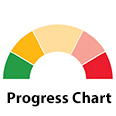Decent work and employment

A farmer in Ambondromisotra, Madagascar, benefits from the HIMO Project, a partnership between the International Labour Organization and Madagascar’s Ministry of Agriculture and Livestock promoting decent jobs through labour-intensive irrigation and rural infrastructure investments.
© ILO/Zoll RabeTrade tensions and uncertainty are expected to dampen GDP growth in 2025
Global real GDP per capita declined sharply by 3.8 per cent in 2020 due to the COVID-19 pandemic. Although it rebounded by 5.5 per cent in 2021, growth slowed to around 2 per cent between 2022 and 2024. Heightened trade tensions, along with policy uncertainty, have significantly weakened the global economic outlook for 2025, with growth projected to slow to 1.5 per cent.
Between 2010 and 2014, the global real GDP per capita grew by 2.0 per cent annually, but slowed to 1.7 per cent for 2015–2023. This deceleration reflects modest slowdowns in most regions and actual declines in sub-Saharan Africa, Latin America and the Caribbean, and Oceania (excluding Australia and New Zealand). LDCs saw growth fall from 3.5 to 1.6 per cent between these periods, while LLDCs dropped more steeply, from 3.9 to 1.5 per cent. These slowdowns pose serious risks to poverty reduction, economic resilience and sustainable transformation.
Real GDP growth in LDCs also remains well below the 7 per cent annual target set by the 2030 Agenda. After a sharp drop to 0.5 per cent in 2020, growth partially recovered to 4.7 per cent in 2022 before slowing again to 3.5 per cent in 2023 and an estimated 3.1 per cent in 2024.
Average annual growth of real GDP per capita, 2010–2014 and 2015–2023 (percentage)

*Excluding Australia and New Zealand.
Global productivity is rebounding slowly, with persistent regional gaps
Labour productivity, measured as GDP per worker per hour, is a key indicator of economic and labour market efficiency. Globally, labour productivity growth rebounded to 1.5 per cent in 2024 after near stagnation in 2022 and 2023, but remains below the 2015–2019 average of 1.8 per cent. The COVID-19 pandemic caused a sharp decline in 2020, and momentum has yet to fully recover. Eastern and South-Eastern Asia showed consistently strong growth, averaging 3.2 per cent from 2020 to 2024, and Central and Southern Asia surpassed 3 per cent in 2024. On the other hand, Latin America and the Caribbean saw negative productivity growth of –1.1 per cent during 2015–2019, but moved towards modest positive growths in 2023 and 2024. Sub-Saharan Africa, Oceania (excluding Australia and New Zealand), and Northern Africa and Western Asia experienced near-zero productivity growth in 2023 and 2024. Weak productivity growth hinders decent work opportunities and real wage increases, complicating sustainable economic recovery and highlighting the need for policies boosting productivity and resilience.
Efforts to end child labour show signs of progress despite missing the 2025 target
While the elimination of child labour remains an unfinished global challenge, recent data provide cautiously optimistic news. Following the concerning rise in child labour documented in 2020, the feared further deterioration in the wake of the COVID-19 pandemic has not materialized. Instead, the world has successfully returned to a trajectory of progress.
In 2024, approximately 138 million children worldwide engaged in child labour, including 54 million in hazardous work endangering their health and development. This represents a significant decrease from 160 million children four years ago. Since 2000, over 100 million fewer children have been in child labour despite the global child population increasing by 230 million. However, the world missed its ambitious target of ending child labour by 2025. To achieve the target within the next five years, the current rate of progress would need to accelerate 11-fold.
Over half of the global workforce remains in informal employment, with numbers still rising
Since 2015, the share of workers in informal employment has edged upward. By 2024, 57.8 per cent of the global workforce was informally employed, meaning they were not adequately covered by social security arrangements, legal protection or workplace safety measures. The 0.2 percentage-point increase from the previous year translates to over 34 million additional informal workers. Although the rate is projected to dip slightly to 57.7 per cent by 2026, another 38 million are expected to enter informal employment.
Informality is highest in low-income countries. In 2024, nearly 9 in 10 workers in sub-Saharan Africa and LDCs were informally employed. Northern Africa and Western Asia, as well as SIDS, saw informality increasing since 2015.
Women are particularly vulnerable in regions where informality is rampant. In 2024, 93.8 per cent of women in LDCs and 91.4 per cent in sub-Saharan Africa were informally employed, compared to 86.4 and 86.0 per cent of men, respectively. Without stronger policies focusing on job quality, informal employment will continue to hinder decent work and inclusive development.
Proportion of informal employment in total employment, 2024 (percentage)

*Excluding Australia and New Zealand.
Tourism recovery gains ground but disparities persist
Tourism holds significant potential to drive sustainable development, livelihoods and nature conservation. In 2023, tourism’s share of the global GDP rebounded to 3.4 per cent, representing over 90 per cent of the 2019 pre-pandemic level and above the 2015–2023 average of 3.3 per cent. From 2015 to 2023, Latin America and the Caribbean led with tourism contributing 4.3 per cent of their GDP, while Central and Southern Asia lagged at 2.2 per cent. When examining countries in special developing status, SIDS showed particularly high dependence on tourism, with the sector averaging 13 per cent of their GDP during this period (excluding Singapore). In contrast, LDCs and LLDCs show considerably lower tourism contributions, at 2.4 and 1.9 per cent, respectively, highlighting the need for targeted investment.
Tourism is also a major source of employment, accounting for 5.6 per cent of global employment between 2015 and 2023, based on data reported by 89 countries. SIDS again stood out with tourism responsible for 12.9 per cent of their total number of employed persons, compared to lower rates in sub-Saharan Africa (2.8 per cent) and Eastern and South-Eastern Asia (4.4 per cent).
Youth face persistent challenges in labour markets despite record-low unemployment
The global unemployment rate fell to a record low of 5.0 per cent in 2024, down from 6.0 per cent in 2015. But disparities and vulnerabilities remain in the labour market, particularly for youth and women. Youth unemployment, while improving to 12.9 per cent in 2024, remains triple the adult rate of 3.7 per cent.
Meanwhile, one in five young people (aged 15–24) globally were NEET in 2024, leaving 259 million youth without opportunities to build skills or gain work experience. This rate has stayed persistently high, with a mere 0.9 percentage-point decrease since 2015. Young women face the greatest barriers and are twice as likely to be NEET as young men. In Central and Southern Asia, 41.9 per cent of young women were NEET, compared to 11.5 per cent of young men. Tackling this challenge requires structural reforms that expand access to education, training and decent work ‒ especially for young women.
Proportion of youth in NEET, by sex, 2024 (percentage)

*Excluding Australia and New Zealand.
Continued erosion of compliance with labour rights undermines progress towards decent-work objectives
Freedom of association and collective bargaining rights are crucial for achieving decent-work objectives. Between 2015 and 2023, global compliance with these fundamental labour rights deteriorated, with the average national compliance score declining by 7 per cent ‒ from 4.54 to 4.86 (on a scale where 0 represents the highest compliance and 10 indicates the lowest. Five of seven regions saw declines, with Eastern and South-Eastern Asia performing the worst. The most severe deterioration occurred among LDCs, which experienced a 45.5 per cent decline in compliance. Developed economies declined by 16.5 per cent.
The deterioration continues to be driven heavily by violations of fundamental civil liberties of workers, employers and their organizations. As free and independent workers’ and employers’ organizations are the very essence of democracy, continued right violation further erode the civic space necessary for the functioning of genuine democracies.

